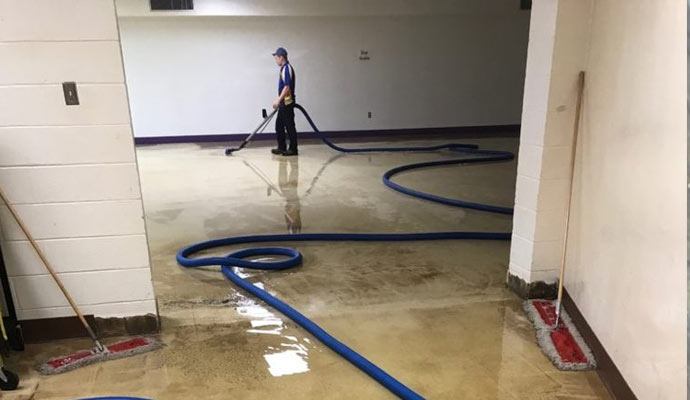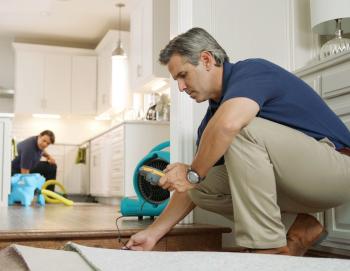Water Damage Restoration 101: Understanding the Process and Expense
Water damage can strike all of a sudden, leaving home owners in a state of complication. Recognizing the repair procedure is necessary for efficient recovery. From evaluating the damage to picking the best company, each action impacts the general outcome and expense. Elements such as the sort of water damage and seriousness also play a substantial function. What are the details techniques utilized in restoration, and exactly how can one get ready for potential expenditures?
Types of Water Damage

Preliminary Analysis and Examination

Water Removal Strategies
Complying with the initial evaluation, effective water removal techniques are used to minimize damage and prevent more problems. These techniques include the use of specific tools such as completely submersible pumps and industrial-grade vacuum cleaners - Water Damage Restoration. The choice of approach depends on the quantity of water present and the kind of materials impacted. For standing water, submersible pumps are usually utilized for quick removal, while vacuums are excellent for drawing out water from rugs and upholstery. In addition, advanced methods like water removal mats might be employed for hard-to-reach locations - Flood Cleanup Services. The objective is to remove as much water as feasible, lessening the capacity for mold development and architectural damage. Prompt and reliable water extraction is important in the overall water damage restoration procedure
Drying Out and Dehumidification Process
When the water removal is total, the drying out and dehumidification procedure becomes crucial to recovering the damaged location. This stage normally employs industrial-grade dehumidifiers and air moving companies to efficiently reduce dampness degrees. The dehumidifiers reel in wet air, removing excess humidity, while air movers flow air to accelerate dissipation. Surveillance equipment is usually made use of to track humidity and temperature level degrees, guaranteeing ideal drying out conditions. The duration of this procedure can differ depending on the extent of the water damage and ecological aspects. It is vital to completely completely dry all impacted materials, including wall surfaces, flooring, and home furnishings, to protect against mold and mildew growth and structural damage. Proper execution of this action is vital for an effective restoration outcome.
Cleaning and Sterilizing Afflicted Areas
A thorough first assessment and assessment of impacted locations is important to identify contamination levels as soon as the drying process is total. Flood Cleanup Services. Reliable cleaning strategies and suitable items have to after that be used to get rid of particles and spots. Lastly, sanitization and disinfection methods are vital to ensure that dangerous microorganisms are eliminated, restoring the room to a secure condition
Initial Evaluation and Examination
Before beginning any reconstruction initiatives, a complete preliminary assessment and examination of the influenced areas are vital for efficient cleaning and disinfecting. This procedure involves determining the level of water damage, establishing the source of the water invasion, and evaluating the products impacted. Inspectors normally search for indicators of mold growth, structural honesty concerns, and damaged items. The evaluation also includes inspecting wetness levels using specific tools to ensure no surprise water pockets continue to be, as these can result in additional complications. Documenting the searchings for is crucial for intending the following action in the restoration procedure. A thorough initial evaluation allows restoration professionals to create a targeted approach for efficient cleansing and sanitizing, eventually lessening damage and wellness risks.
Cleansing Techniques and Products
Efficient cleaning and sterilizing of water-damaged locations call for a selection of items and strategies tailored to the details products influenced. For permeable surfaces like drywall and carpeting, extraction methods are vital to eliminate excess wetness, complied with by deep cleansing with specialized cleaning agents. Non-porous products such as tile or metal can be cleaned utilizing commercial-grade cleansers that efficiently eliminate contaminants. Vapor cleaning is another efficient strategy, especially for rugs and upholstery, as it utilizes high temperature levels to remove bacteria and mold and mildew (Flood Cleanup Services). Additionally, green items are significantly popular for their safety and efficiency - Mold Remediation After Water Damage. Inevitably, selecting the proper cleansing methods and items not only assures prompt tidiness however also help in protecting against further damage and carcinogen connected with water intrusion
Sanitization and Disinfection Approaches
When resolving water damage, appropriate sanitization and disinfection methods are important to assure the security and health of the damaged environment. After initial cleansing, surface areas have to be treated with suitable anti-bacterials to remove pathogens, mold, and microorganisms that grow in damp problems. Typical approaches include the usage of EPA-approved chemical disinfectants, which can be applied via spraying or cleaning methods. In addition, ultraviolet (UV) light systems can successfully disinfect locations by counteracting bacteria without rough chemicals. The selection of method typically depends upon the type of products impacted and the degree of contamination. Inevitably, extensive sanitization not just restores a safe living room however likewise assists protect against future health and wellness dangers connected with remaining wetness and mold and mildew development.

Fixings and Restoration Options
Reviewing the damage brought on by water exposure is vital for identifying the ideal repair work and reconstruction options. Property owners might encounter numerous issues, including harmed drywall, warped flooring, and jeopardized architectural components. Relying on the extent of the damage, repair services might entail changing sections of drywall, setting up new flooring, or reinforcing structural light beams. In instances of serious damage, complete replacement of damaged products may be required. Additionally, professional Resources restorers often advise utilizing moisture meters to evaluate concealed moisture degrees prior to choosing the very best strategy. It is essential to act promptly to avoid mold and mildew growth and additional wear and tear. Choosing the right alternatives not just brings back the building but also assures long-lasting security and functionality.
Variables Influencing Restoration Prices

The degree of water damage straight affects the remediation sets you back house owners can anticipate to incur. Variables such as the source of the water, the period of exposure, and the afflicted products significantly affect rates. As an example, clean water damage from a damaged pipeline is typically less costly to bring back contrasted to damage brought on by sewer. Additionally, the level of contamination dictates the requirement for specialized cleansing and disposal solutions, further boosting expenditures. Geographical place additionally plays a role, as regional labor rates and schedule of restoration services can vary. The necessity of the reaction impacts prices; quicker treatments typically lead to lower overall costs by stopping additional damage. Recognizing these elements is essential for homeowners when estimating repair expenses.
The three primary kinds of water damage are categorized based on contamination levels: tidy water, gray water, and black water. An extensive preliminary evaluation and assessment are important steps in the water damage restoration procedure. For standing water, completely submersible pumps are commonly made use of for quick elimination, while vacuums are perfect for extracting water from carpetings and furniture. The degree of water damage straight affects the remediation costs property owners can anticipate to incur. Tidy water damage from a damaged pipeline is normally much less costly to restore contrasted to damage triggered by sewage.